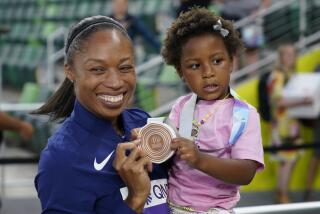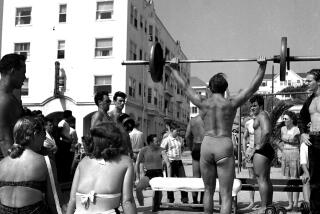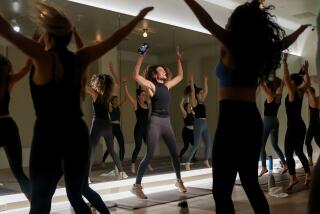Workout partners
You won’t hear hip-hop or techno music blasting from the speakers in this fitness class. And though some of the members are working hard to slim down and firm up, others couldn’t care less about their chubby thighs and rounded tummies.
That’s because this class -- at the Hollywood YMCA -- is made up of moms and their young children. Like many fitness classes, an instructor leads participants through a series of exercises. The twist is that the moms -- and the occasional dad -- may incorporate their children into the workout, holding them for added effort during squats and lunges, resting the children on their stomachs for greater resistance during abdominal work or just allowing them to lie alongside during leg lifts or stretches.
Not surprisingly, the parents play by the kids’ rules. The music is classic nursery songs -- “Row, Row, Row Your Boat,” “Puff, the Magic Dragon,” the “Lilo and Stitch” soundtrack. If the children -- babies and toddlers -- aren’t interested in participating with their parents, instructor Maegan Robins lets them play with big, colorful exercise balls scattered around the room. Timeouts may be taken for breast-feeding.The class, Parents Plus Fitness, is just one of the latest offerings for moms and dads who want to work out with their babies.
A survey, released last fall, of 281 health club owners and managers in the United States and Canada, found that 17% have parent-and-baby fitness classes. And 58% of those offering the classes think the trend is growing, said a survey by the IDEA Health & Fitness Assn. in San Diego.
Some gyms offer water classes in which parents get an added workout by lifting babies and doing lunges across the pool.
But parents don’t have to belong to a gym to exercise with their little ones. Some yoga studios, such as Golden Bridge in Los Angeles and the Yoga Kingdom Sanctuary in Pasadena, offer classes that allow moms to strike some poses with their babies. Outdoor stroller classes, such as Stroller Strides (in California and many states nationwide) and Strollercize (on the East Coast), also help moms to get their heart rate up, tone and stretch.
Books, too, have gotten in on the act. “Buff Moms” by Sue Fleming and “Bounce Back Into Shape After Baby” by Caroline C. Creager offer tips for working out with babies at home.
And there are various videos, such as “The Method: Baby & Mom Post Natal Yoga,” by Gurmukh Khalsa of Golden Bridge. Another is “Strollertime: A Complete Workout With Baby in Tow,” by trainer Tara Smith, which includes a CD that guides moms on a 30-minute power walk and a DVD that covers toning exercises to do at home, some of them incorporating the baby.
The appeal of these programs is easy to see. For parents of young children, finding the time to exercise is hard enough, without also having to find and pay for a baby-sitter to make it happen. Some fitness facilities have child care, but babies and young children may pitch a fit long before mom ever breaks a sweat, and some moms are reluctant to leave their little ones with strangers.
The obvious solution for mothers such as Kirsten Miller is to bring the tyke along.
“It’s hard to get baby up and changed and get to class,” says Miller, a stay-at-home mom from Los Angeles. When her 11-month-old son was younger, she took mother-baby yoga classes. Now, she walks every day with her son and also attends the weekly Parents Plus Fitness class, which she says is one of the more challenging kid-friendly ones she’s taken.
“You really get a burn,” she says.
Miller gained 50 pounds during pregnancy. She lost most of it within six months but is still working to shed the last 15 pounds.
It’s a battle many women face, and an important one for their long-term health, says Brenda Rooney, an epidemiologist at the Gundersen Lutheran Medical Center in La Crosse, Wis., who has studied post-partum exercise and weight loss.
“Right from the time you have clearance from your doctor, get back into [exercise],” she says.
Rooney followed 540 women for almost 10 years and found that those who had lost all their pregnancy weight within six months were about five pounds heavier a decade later, whereas those who hadn’t lost the weight were 18 pounds heavier. And unpublished data at the 15-year mark show the overweight women becoming even more obese.
The findings don’t necessarily mean women who are still carrying extra weight after six months won’t ever lose it, she says, but the odds decrease with time. “A year is a good time to take stock” of weight-loss efforts, she says.
How soon women can resume physical activity after delivery varies by individual, with some women who had uncomplicated births exercising within just days, according to the American College of Obstetricians and Gynecologists. Others will have to hold off a little longer.
Women who’ve had a Caesarean section, for instance, may need to wait six to eight weeks before returning to their normal pre-pregnancy exercise routine, says ACOG spokesman Dr. Raul Artal, professor and chairman of obstetrics, gynecology and women’s health at St. Louis University School of Medicine. Elizabeth Cronin, who also has taken the Parents Plus Fitness class, says working out with baby is helpful, but not ideal.
“Probably the best thing is to not have your kid around at all when you work out,” says Cronin, a mother of an 18-month-old boy. “Because otherwise you’re glancing over: ‘Where’s my kid? Is he running in the hall? Does he want to be held?’ ”
Even if mothers aren’t getting as much physical activity as they’d like, Rooney says, exercising with baby can have another important benefit: modeling healthy behavior.
“The baby sees mom exercising and that idea becomes the norm,” she says.
During a recent morning at the Hollywood YMCA, one 19-month-old girl took the opportunity to steal Robins’ instructor spot at the front of the studio. Lying on the mat, she began demonstrating stretching exercises as if she’d been doing them all her life.


